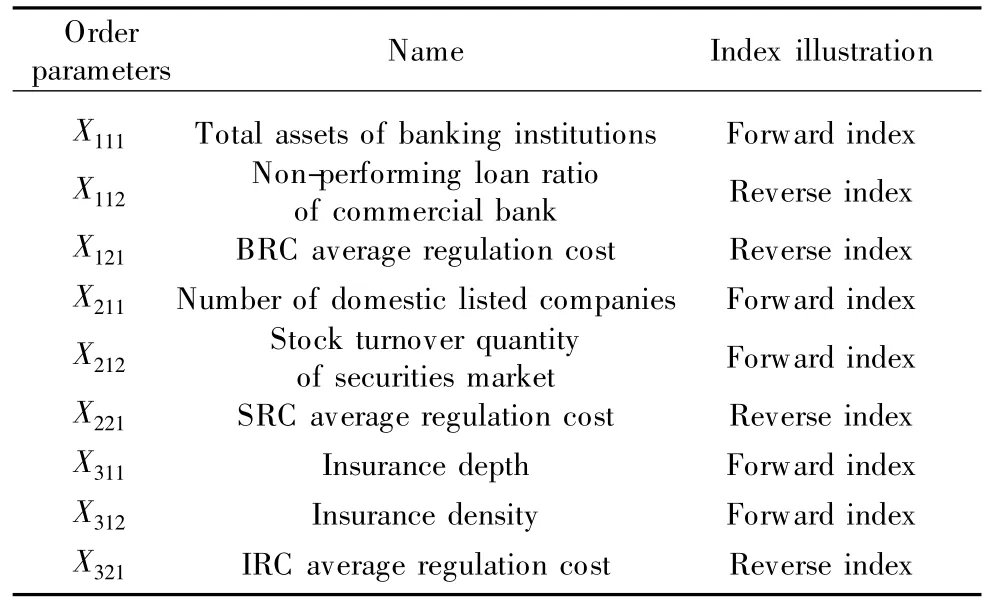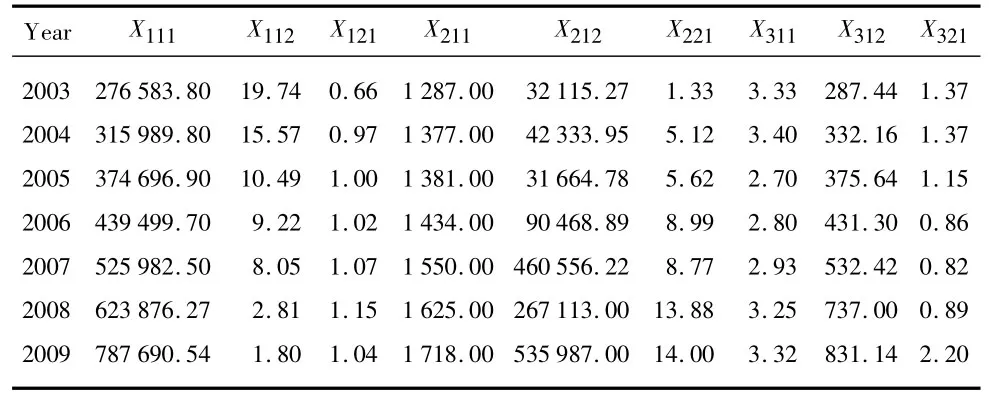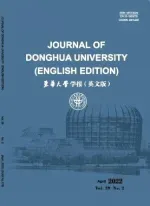Research on Cooperation Mechanism ofChina'sFinancialRegulation and Supervision System
2012-02-07ZHAOWeihua赵卫花TANGBingyong汤兵勇JIGuangkai姬广凯
ZHAO Wei-hua(赵卫花),TANG Bing-yong(汤兵勇),JI Guang-kai(姬广凯)
1 Dean′s Office of Donghua University,Shanghai 201620,China
2 Glorious Sun School of Business and Management,Donghua University,Shanghai 200051,China
Introduction
The finance of China has changed a lot during the 30 years of reform and opening up.Especially after China's entry into the WTO,researches about finance are more and more of practical importance.Financial industry is closely related to nationaleconomy and socialdevelopment.Its effective operation can promote the development of economy and increase the total social welfare.Financial industry includes three subindustries,i. e.,banking,securities,and insurance.Calculation of the regulatory cost,efficiency,and validity scientifically can provide reference for the financial regulators to make the appropriate policy decision.In 1937,Ludwig Von Bertalanffy,an Austrian theoretical biologist defined that system was an interactional component complex[1].For a complex system,the practice of financial regulation and supervision system is external,while the subsystem's synergetic movements are the internal motivations of the system.The interaction between the components helps the system become an orderly integrity[2].Li et al.[3]applied the synergetics to financial supervision research and gave an argument on the feasibility.Tang et al.[4]constructed a harmonious development index model and proposed a corresponding evaluation calculation method.Luo[5]carried out an empirical research on China's financial regulation and supervision system by geometry average method.But this method can only lead to invalid solution and the result is not quite accurate.In this paper,the method of system evaluation was improved by choosing the arithmetic average method,and the system's order degree was analyzed from the view of system science and synergetics.Then a more exact result was drawn.
1 Modelling
1.1 Structure of financial regulation and supervision system
Luo[5]considered that it was the costs and benefits that dominated the order parameters of the system,which was widely accepted.However,there is still not a unified statistical method about regulatory costs and benefits,as well as index choosing.In this paper,the costs index was chosen in the process ofmodeling aftercomparing the advantagesand disadvantages of the benefits and costs index.
1.1.1 Regulatory benefits index
Benefits are measured by the satisfaction from the financial institutions,the financial system,and the whole economic system in some aspects,such as competition,efficiency,justice,and stability through regulation and supervision.So it is difficult to be quantized.Benefits may bring something like the financial system orderliness,which can't be measured by quantized index.It can be measured both from the microscopic level and macroscopic level. Firstly,it can increase the supervisee's income.The financial regulation and supervision create a good competitive environmentforthe financial institutions and increase the profitability of them.But it may work after a long time.Secondly,the revenue of the whole financial system will be increased.Regulation guards against the monopoly,protects the legal competition,prevents the system risks,and improves the efficiency of the financial mechanism.Thirdly,it impels the welfares of the society to rise.Because of the regulation and supervision,good financial mechanism can raise the resources utilization so that the economy grows fast,and the welfare benefits of the society raise.However,these benefits are manifested indirectly because they cannot be calculated directly.In the financial system,the important features representing the industry development are industry scale,asset quality,and systematic risk.
1.1.2 Regulatory costs index
The costs of financial regulation and supervision can be divided into two types:direct and execution costs.Direct costs,also called administrative execution costs,are paid for employees and daily expenses in the process of regulatory execution.It can be easily measured and reflected in the regulators'annual reports.While execution costs are paid for theregulation by financialinstitutions being supervised,including information costs,and internal supervision costs which are required to be paid to the regulators,such as deposit reserve ratio,deposit insurance,and provision for bad debts.These are the mandatory requirements for the supervised.In the financial industry regulation,direct costs can be weighed by operating costs of Banking Regulatory Commission(BRC),Securities Regulatory Commission(SRC),and Insurance Regulatory Commission(IRC),and indirect costs weighed by the number of agencies and assesses.Owing to the peculiar risk character of financial system,the risk issues must be taken into consideration while measuring the efficiency of regulation,so risk indicator can not be ignored when modeling.
In this paper,China's financial regulation and supervision system is chosen as a large system with three subsystems,banking,securities,and insurance.And each subsystem can be further divided into two secondary subsystems:supervisory mechanism and supervised mechanism.The financial regulation and supervision system model based on costs is built,as shown in Fig.1.

Fig.1 Financial regulation system decomposition
1.2 The synergetic degree of financial regulation
1.2.1 Definition of order parameters
Order parameters play key roles in systems.Under the effect of order parameter,the system becomes self-organized and orderly directed.Firstly use i to symbolize subsystem,j to symbolize secondary subsystem,q=(q1,q2,…,qn)are state variables.Use xijkto symbolize order parameters,thus the parameter of a secondary subsystem in the financial regulation can be defined as:xij=(xij1,xij2,… ,xijn)n≥2,βijk≤xijk≤αijk,k∈[1,n].βijkis the lower limit value of the parameter;αijkis the upper limit value.
1.2.2 Definition of degree of order
Degree of order is comprised of forward index and reverse index,also named large-scale index and small-scale index,respectively.The larger the value of forward index is,the more“contributions”it will make to order degree of system,vise versa.The reverse index is defined on the contrary.The formulas are as follows:

where φijk,φijkare the order degrees of order parameter xijkin this paper.Define μ1as the order degree of banking regulation subsystem,μ2as the order degree of securities regulation subsystem,and μ3as the order degree of insurance regulation subsystem.
2 Index Selection
Total assets of banking institutions and non-performing loan ratio of state-owned commercial banks are chosen as order parameters of secondary subsystem of banking.BRC average regulation cost is chosen as the BRC regulation order parameter.The number of listed companies and the stock turnover quantity of securities market are chosen as order parameters of the securities secondary subsystem.SRC average regulation cost is chosen as order parameter ofSRC secondary subsystem.Insurance depth and insurance density are chosen as order parameters of the insurance secondary subsystem.IRC average regulation cost is chosen as order parameter ofthe IRC regulation secondary subsystem.
Ye et al.[6]researched China's financial regulatory index system,and built a financial regulatory index based on China's banking industry.In this paper,two indexes were selected from Ref.[5]representing scale and asset quality:total assets of financial institutions of banking industry and non-performing loan ratio of assets of state-owned commercial banks.The number of listed companies and stock turnover quantity of securities market are selected from the subsystem of securities industry.Insurance depth and insurance density are selected from insurance system.The symbols are described in Table 1.X311refers to the ratio of certain area's premium income to its GDP,and reflects that the position of this area's insurance industry in national economy is determined by this area's total development and insurance industry's development speed.X312refers to the average premium income based on the local population and reflects the degree of the local people in insurance and the developmentofnationaleconomy and insurance industry.The direct regulation costs choose the expenses of employees and daily operation undertaking in the process of policy making and executing,including direct costs and execution costs.Direct costs are weighed by employees'income through years and chosen the mean.Execution costs are gained through the experience method which regards that the institution's execution costs equal fourfold direct costs.Define T as regulation costs,D as direct costs,E as execution costs,S as number of regulation staffs,I as average annual income of staffs,T1as regulation costs of BRS,T2as regulation costs of SRS,T3as regulation costs of IRS,R as assets of BRS,O as assets of IRS,L as listed companies of SRS,and V as investors'accounts of SRS.The formulas are as follows.


Table 1 Order parameters of financial regulation and supervision
3 Results and Analysis of Empirical Research
3.1 Data
Define the sample interval as 2003-2009.Choose sample data from China Statistical Yearbook[7],Almanac of China's finance and banking[8],Yearbook of China's Insurance[9],Shanghai Stock Exchange Statistics Annual[10],and Shenzhen Stock Exchange Fact Book[11].Sample data are shown in Table 2.

Table 2 Sample data
3.2 Order degree
According to the definition of degree of order in Section 1.2.2,we can draw the degree of order in Table 3.This process is also called normalization.

Table 3 Normalization of sample data
3.3 Results
There are a variety of system evaluation methods,and the linear weighted assessmentmethod andgeometric weighted assessment method can be found in Ref.[12].Luo[5]chose the geometric weighted assessment method to carry out system evaluation,but this method could result in invalid number.So in this paper we choose linear weighted average method to evaluate the order degree of the three subsystems of China's financial regulation and supervision system.It is one of the system evaluation methods.The calculation process is simple and it won't lead to invalid solution.Formulas and results are as follows.

From Table 4,the order degree of banking regulation subsystem is rising overall from the year 2003 to 2009.This is consistent with the fact that Chinese government has always carried out robust policies in bank industry.While the order degree of securities regulation subsystem undergoes ups and downs in 2003-2009.In the early time of 90s,the securities industry of China present good development tendency,but showed chaos in the later due to the lack of supervision for the diversification operation.The orderdegree of insurance regulation subsystem of China is rising overall.

Table 4 Order degree of China's financial regulation and supervision system
4 Conclusions
A model about the synergy degree of China's financial regulation and supervision was improved.And the result shows the order degree of the banking regulation system and insurance regulation system is stable overall and presents up trend,while the order degree of securities regulation system undergoes ups and downs.With the trend of the comprehensive operation of finance,unified supervision becomes very important.China's capital market needs enhancement.Chinese government must carry out comprehensive supervision to improve efficiency and avoid risk of comprehensive operation.
[1]VonBertalanffy L. General System Theory:Foundation Development Application[M].Qiu T,Yuan J X,translator.Beijing:Social Science Academic Press,1987.(in Chinese)
[2]Haken H.Synergetics[M].Lin F H,translator.Shanghai:Shanghai Translation Publishing House,2001:108-137.(in Chinese)
[3]Li L Y,Luo J.An Analysis of the Cooperation Mechanism for FinancialRegulation and Supervision in China-Based on Synergetics Theory[J].The Theory and Practice of Finance and Economics,2008,29(2):22-26.(in Chinese)
[4]Tang B Y,Zhang W Y.The Coordinate Developmental Index Model[J].Systems Enging-Theory Methodology Applications,1996,5(3):18-22.(in Chinese)
[5]Luo J.The Research on the Cooperation Mechanism for Financial Regulation and Supervision in China[D].Hunan:Hunan University,2010:62-70.(in Chinese)
[6]Ye Y G,Zhang P.On the Financial Supervision Indicator System in China[J].Journal of Financial Research,2009(4):159-171.(in Chinese)
[7]China Statistical Yearbook[EB/OL].(2004-2010)[2011-10-15].http://www.chinayearbook.com/.(in Chinese)
[8]Almanac of China's Finance and Banking[CD/OL].(2004-2010)[2011-10-15].http://www.chinayearbook.com/.(in Chinese)
[9]Yearbook of China's Insurance[EB/OL].(2004-2010)[2011-10-15].http://www.chinayearbook.com/.(in Chinese)
[10]Shanghai Stock Exchange Statistics Annual[EB/OL].(2004-2010)[2011-10-15].http://www.sse.com.cn/sseportal/ps/zhs/home.html.(in Chinese)
[11]Shenzhen Stock Exchange Fact Book[EB/OL].(2003-2009)[2011-10-15].http://www.szse.cn/.(in Chinese)
[12]Hao H,Zong J F.Method of System Analysis and Evaluation[M].Beijing:Economic Science Press,2007:64-68.(in Chinese)
杂志排行
Journal of Donghua University(English Edition)的其它文章
- Frost Resistance and Damage Velocity of Compressively Preloaded Concrete
- Vehicle OHT DispatchingPerformance Analysis ofan AMHS in 300mm Semiconductor FABs
- Determination of the Dose of PAC in Ultrafiltration System for Drinking Water Treatment
- Hydrophobic TixOy-CmHnNanoparticle Film Prepared by Plasma Enhanced Chemical Vapor Deposition
- Comparison and Analysis of Fabric Deodorization Test Methods
- Sorption Kinetics and Capacity of Composite Materials Made up of Polymeric Fabric and Expanded Perlite for Oil in Water
